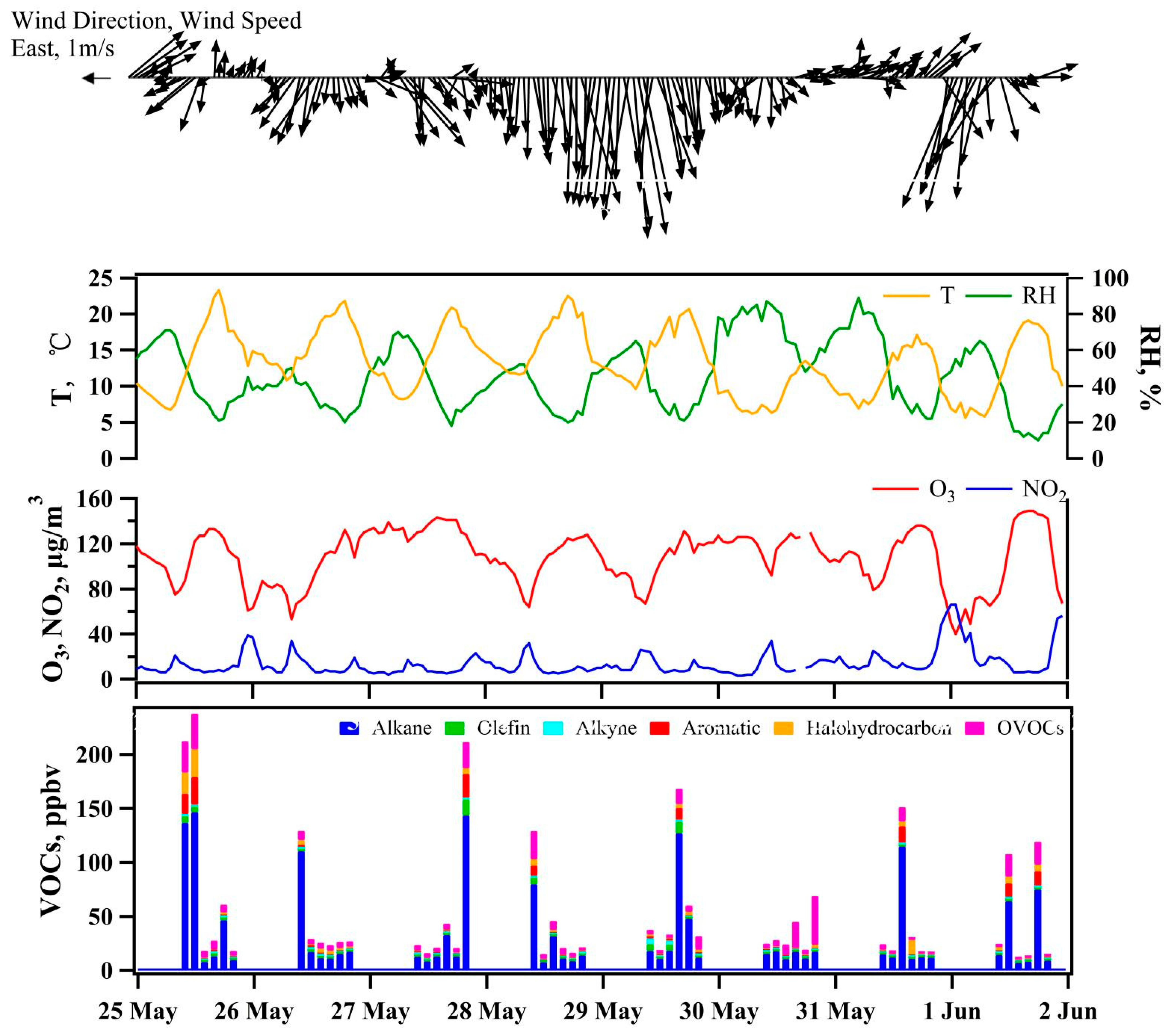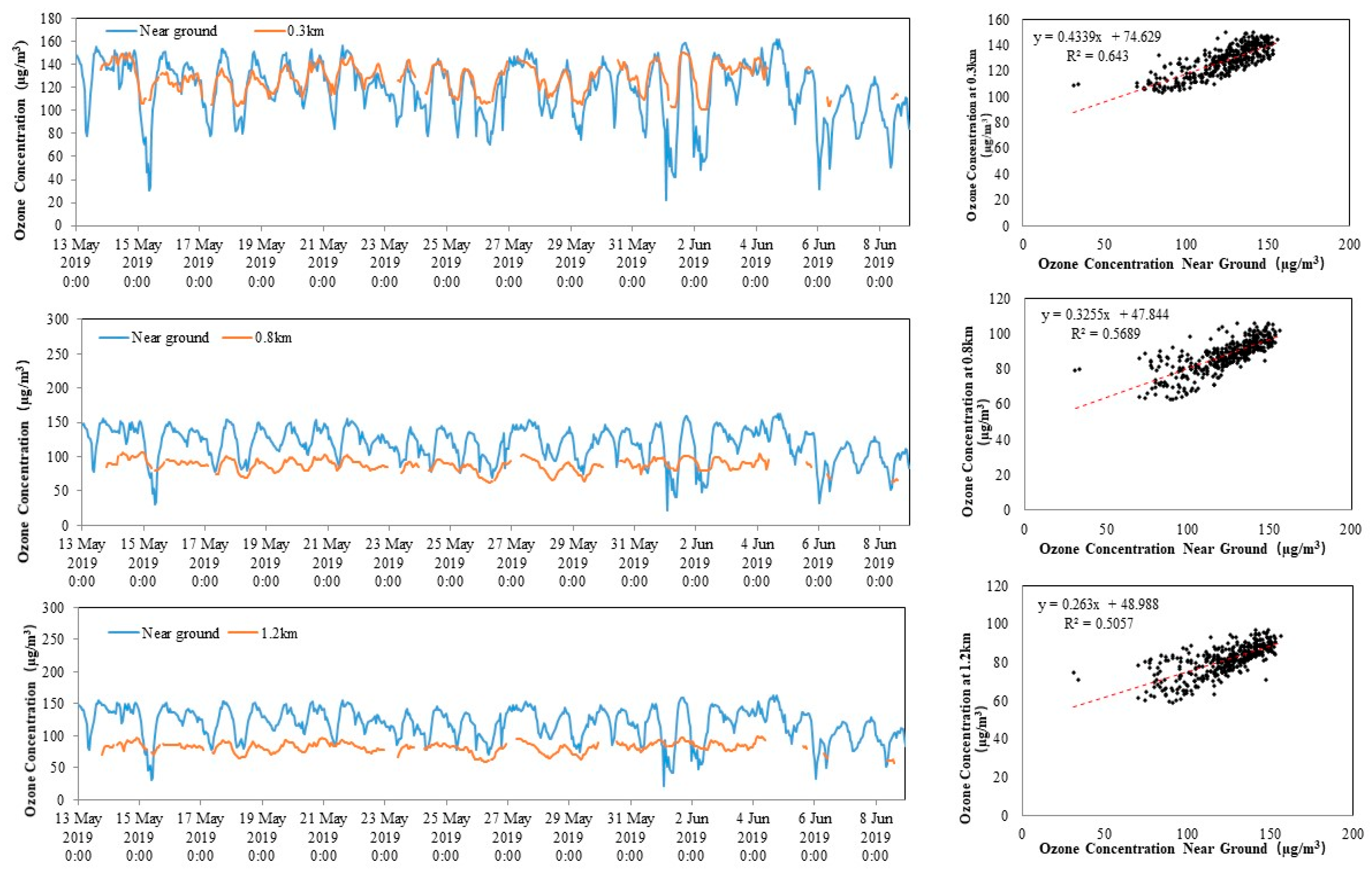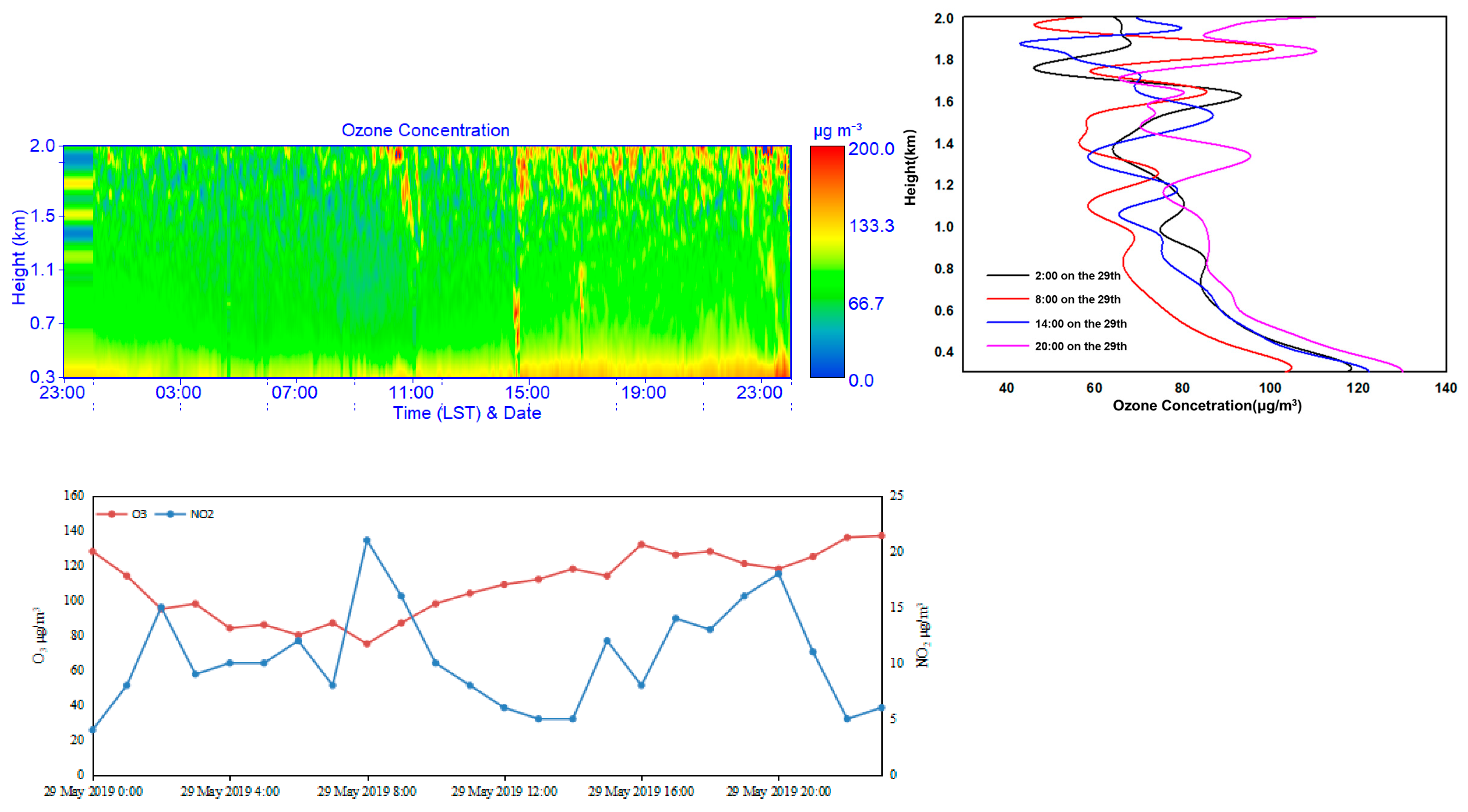Ozone Profiles, Precursors, and Vertical Distribution in Urban Lhasa, Tibetan Plateau
Abstract
:1. Introduction
2. Materials and Methods
2.1. Observation of Air Quality and VOCs
2.2. Ozone Lidar Observation
2.3. Observational-Based Model Study
3. Results
3.1. General Characteristics of Ozone, NOx, and VOCs Profiles


3.2. Mechanism of Ozone Formation and Its Vertical Distribution


3.3. Case Studies
4. Discussion
5. Conclusions
- Ozone changes in an apparent daily trend with a single peak, the VOC concentrations fluctuate significantly, and the pollution concentration and change characteristics of each component vary greatly. They were likely caused by multiple factors such as human activities on the ground and photochemical reactions. The urban areas of Lhasa were under transition conditions and controlled by both VOCs and NOx. Moreover, the most effective way to decrease ozone formation is to reduce the emissions of anthropogenic VOCs and NOx.
- From the perspective of the vertical distribution of near-ground ozone, the areas with high ozone concentrations in Lhasa are mainly concentrated within 400 m and carry apparent daily trends of an alternation. The changing ozone trends at different altitudes of 0.3 km, 0.5 km, and 1.2 km indicate that the vertical transmission of ozone is affected by the atmospheric boundary layer and the mixing difference caused by it. Because the photochemical reaction and a long time of sunshine are conducive to the generation and accumulation of ozone, high ozone concentrations occur from 12:00 to 23:00. Due to changes in diffusion and emission conditions, cumulative pollution exist both during the day and the previous night, and sometimes short-term titration also exists. The results also imply that Lhasa city is an essential source of ozone in the TP.
- The results are essential to understanding the formation and impacts of ozone in the TP.
Supplementary Materials
Author Contributions
Funding
Data Availability Statement
Acknowledgments
Conflicts of Interest
References
- Burkholder, J.B.; Cox, R.A.; Ravishankara, A.R. Atmospheric Degradation of Ozone Depleting Substances, Their Substitutes, and Related Species. Chem. Rev. 2015, 115, 3704–3759. [Google Scholar] [CrossRef] [PubMed]
- Li, D.; Vogel, B.; Müller, R.; Bian, J.; Günther, G.; Li, Q.; Zhang, J.; Bai, Z.; Vömel, H.; Riese, M. High tropospheric ozone in Lhasa within the Asian summer monsoon anticyclone in 2013: Influence of convective transport and stratospheric intrusions. Atmos. Chem. Phys. 2018, 18, 17979–17994. [Google Scholar] [CrossRef] [Green Version]
- Brook, R.D.; Franklin, B.; Cascio, W.; Hong, Y.; Howard, G.; Lipsett, M.; Luepker, R.; Mittleman, M.; Samet, J.; Smith, S.C.; et al. Air pollution and cardiovascular disease: A statement for healthcare professionals from the Expert Panel on Population and Prevention Science of the American Heart Association. Circulation 2004, 109, 2655–2671. [Google Scholar] [CrossRef] [PubMed]
- Hallquist, M.; Wenger, J.C.; Baltensperger, U.; Rudich, Y.; Simpson, D.; Claeys, M.; Dommen, J.; Donahue, N.M.; George, C.; Goldstein, A.H.; et al. The formation, properties and impact of secondary organic aerosol: Current and emerging issues. Atmos. Chem. Phys. Discuss. 2009, 9, 3555–3762. [Google Scholar] [CrossRef] [Green Version]
- Ma, Z.; Zhang, X.; Xu, J.; Zhao, X.; Meng, W. Characteristics of ozone vertical profile observed in the boundary layer around Beijing in autumn. J. Environ. Sci. 2011, 23, 1316–1324. [Google Scholar] [CrossRef]
- Salmond, J.A.; McKendry, I.G. Secondary ozone maxima in a very stable nocturnal boundary layer: Observations from the Lower Fraser Valley, BC. Atmos. Environ. 2002, 36, 5771–5782. [Google Scholar] [CrossRef]
- Shi, G.Y.; Bai, Y.B.; Iwasaka, Y.; Ohashi, T. A balloon measurement of the ozone vertical distribution over lahsa. Adv. Earth Sci. 2000, 15, 522–524. [Google Scholar]
- Pazmiño, A.; Godin, S.; Wolfram, E.; Lavorato, M.; Porteneuve, J.; Quel, E.; Mégie, G. Intercomparison of ozone profiles measurements by a differential absorption lidar system and satellite instruments at Buenos Aires, Argentina. Opt. Laser Eng. 2003, 40, 55–65. [Google Scholar] [CrossRef]
- Wang, L.; Follette-Cook, M.B.; Newchurch, M.J.; Pickering, K.E.; Pour-Biazar, A.; Kuang, S.; Koshak, W.; Peterson, H. Evaluation of lightning-induced tropospheric ozone enhancements observed by ozone lidar and simulated by WRF/Chem. Atmos. Environ. 2015, 115, 185–191. [Google Scholar] [CrossRef]
- Chi, X.; Liu, C.; Xie, Z.; Fan, G.; Wang, Y.; He, P.; Fan, S.; Hong, Q.; Wang, Z.; Yu, X. Observations of ozone vertical profiles and corresponding precursors in the low troposphere in Beijing, China. Atmos. Res. 2018, 213, 224–235. [Google Scholar] [CrossRef]
- Xing, C.; Liu, C.; Wang, S.; Chan, K.L.; Gao, Y.; Huang, X.; Su, W.; Zhang, C.; Dong, Y.; Fan, G. Observations of the vertical distributions of summertime atmospheric pollutants and the corresponding ozone production in Shanghai, China. Atmos. Chem. Phys. 2017, 17, 14275–14289. [Google Scholar] [CrossRef] [Green Version]
- Zhu, B.; Hou, X.; Kang, H. Analysis of the seasonal ozone budget and the impact of the summer monsoon on the northeastern Qinghai-Tibetan Plateau. J. Geophys. Res. Atmos. 2016, 121, 2029–2042. [Google Scholar] [CrossRef] [Green Version]
- Liang, W.; Yang, Z.; Luo, J.; Tian, H.; Bai, Z.; Li, D.; Li, Q.; Zhang, J.; Wang, H.; Ba, B. Impacts of the atmospheric apparent heat source over the Tibetan Plateau on summertime ozone vertical distributions over Lhasa. Atmos. Ocean. Sci. Lett. 2021, 14, 100047. [Google Scholar] [CrossRef]
- Chen, Y.; Zhang, S.; Peng, C.; Shi, G.; Tian, M.; Huang, R.J.; Guo, D.; Wang, H.; Yao, X.; Yang, F. Impact of the COVID-19 pandemic and control measures on air quality and aerosol light absorption in Southwestern China. Sci. Total Environ. 2020, 749, 141419. [Google Scholar] [CrossRef]
- Wang, X.; Zhang, T.; Xiang, Y.; Lv, L.; Fan, G.; Ou, J. Investigation of atmospheric ozone during summer and autumn in Guangdong Province with a lidar network. Sci. Total Environ. 2021, 751, 141740. [Google Scholar] [CrossRef]
- Su, R.; Lu, K.; Yu, J.; Tan, Z.; Jiang, M.; Li, J.; Xie, S.; Wu, Y.; Zeng, L.; Zhai, C.; et al. Exploration of the formation mechanism and source attribution of ambient ozone in Chongqing with an observation-based model. Sci. China Earth Sci. 2018, 61, 23–32. [Google Scholar] [CrossRef]
- Zhao, Z.-Y.; Cao, F.; Fan, M.-Y.; Zhang, W.-Q.; Zhai, X.-Y.; Wang, Q.; Zhang, Y.-L. Coal and biomass burning as major emissions of NOx in Northeast China: Implication from dual isotopes analysis of fine nitrate aerosols. Atmos. Environ. 2020, 242, 117762. [Google Scholar] [CrossRef]
- Zhang, X.; Hu, B.; Wang, Y.; Zhang, W.; He, Y.; Sun, W. The analysis of variation characteristics and establishing of estimating equation for ultraviolet radiation in Lhasa. Chin. J. Atmos. Sci. 2012, 36, 744–754. [Google Scholar]
- Wang, W.; van der A, R.; Ding, J.; van Weele, M.; Cheng, T. Spatial and temporal changes of the ozone sensitivity in China based on satellite and ground-based observations. Atmos. Chem. Phys. 2021, 21, 7253–7269. [Google Scholar] [CrossRef]
- Xiong, C.; Wang, N.; Zhou, L.; Yang, F.; Qiu, Y.; Chen, J.; Han, L.; Li, J. Component characteristics and source apportionment of volatile organic compounds during summer and winter in downtown Chengdu, southwest China. Atmos. Environ. 2021, 258, 118485. [Google Scholar] [CrossRef]
- Tan, Z.; Lu, K.; Jiang, M.; Su, R.; Dong, H.; Zeng, L.; Xie, S.; Tan, Q.; Zhang, Y. Exploring ozone pollution in Chengdu, southwestern China: A case study from radical chemistry to O3-VOC-NOx sensitivity. Sci. Total Environ. 2018, 636, 775–786. [Google Scholar] [CrossRef]
- Xiu, T.; Sun, Y.; Sun, T.; Wang, Y. The vertical distribution of ozone and boundary layer structure analysis during summer haze in Beijing. Acta Sci. Circumstantiae 2013, 33, 321–331. [Google Scholar] [CrossRef]
- Peng, L.; Gao, W.; Geng, F.; Ran, L.; Zhou, H. Analysis of Ozone Vertical Distribution in Shanghai Area. Acta Sci. Nat. Univ. Pekin. 2011, 47, 805–811. [Google Scholar] [CrossRef]




| Date | O3-8h (µg/m3) | NO2 (µg/m3) | VOCs (ppbv) | Average Daily T (°C) | T Difference (°C) | Maximum Daily T (°C) | Daily Average RH (%) | Daily Minimum RH (%) |
|---|---|---|---|---|---|---|---|---|
| 25 May | 126 | 16 | 96 | 14 | 17 | 23 | 46 | 21 |
| 26 May | 122 | 13 | 44 | 16 | 11 | 22 | 35 | 20 |
| 27 May | 142 | 11 | 56 | 14 | 13 | 21 | 45 | 18 |
| 28 May | 126 | 13 | 42 | 16 | 11 | 23 | 37 | 20 |
| 29 May | 122 | 14 | 58 | 15 | 11 | 21 | 42 | 21 |
| 30 May | 129 | 13 | 35 | 9 | 7 | 14 | 71 | 48 |
| 31 May | 133 | 17 | 44 | 12 | 10 | 17 | 53 | 22 |
| 1 June | 146 | 26 | 50 | 12 | 14 | 19 | 36 | 10 |
Publisher’s Note: MDPI stays neutral with regard to jurisdictional claims in published maps and institutional affiliations. |
© 2022 by the authors. Licensee MDPI, Basel, Switzerland. This article is an open access article distributed under the terms and conditions of the Creative Commons Attribution (CC BY) license (https://creativecommons.org/licenses/by/4.0/).
Share and Cite
Yu, J.; Meng, L.; Chen, Y.; Zhang, H.; Liu, J. Ozone Profiles, Precursors, and Vertical Distribution in Urban Lhasa, Tibetan Plateau. Remote Sens. 2022, 14, 2533. https://doi.org/10.3390/rs14112533
Yu J, Meng L, Chen Y, Zhang H, Liu J. Ozone Profiles, Precursors, and Vertical Distribution in Urban Lhasa, Tibetan Plateau. Remote Sensing. 2022; 14(11):2533. https://doi.org/10.3390/rs14112533
Chicago/Turabian StyleYu, Jiayan, Lingshuo Meng, Yang Chen, Huifang Zhang, and Jianguo Liu. 2022. "Ozone Profiles, Precursors, and Vertical Distribution in Urban Lhasa, Tibetan Plateau" Remote Sensing 14, no. 11: 2533. https://doi.org/10.3390/rs14112533






